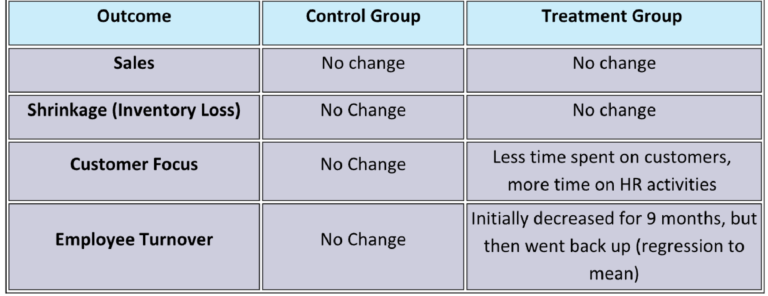An article by Quantum Workspace argues that employee retention increases a firm’s financial performance. Similarly, an article in The Times argues that reducing employee turnover should be the main goal of a successful business, arguing that “Britain’s workforce walking out the door costs the economy vast sums of money every year, but fixing it isn’t hard.”
This conventional wisdom may be wrong. A randomized study published in the prestigious journal Management Science reveals a counterintuitive finding: middle-management’s efforts to minimize turnover not only fail to boost financial performance but also harm customer service and increase operational inefficiencies.

Study
The study analyzed data from a long-term field experiment in a large European retail chain.
- Sample: The sample included 193 retail stores, with a focus on middle managers and their
teams. - Sample Size: Over 30,000 employees and millions of transactions were evaluated.
- Randomized Intervention: In the treatment group managers are asked to put more
attention and focus on employees to reduce turnover; status quo in the control group - Outcome Metrics:
o Turnover Rates: Employee turnover at each store.
o Financial Performance: Revenue (sales), shrinkage (inventory loss).
o Customer Focus: Time employees spent serving customers.
- Analysis: A randomized intervention was implemented to shift managerial attention
towards reducing turnover. The study used econometric models to assess the causal impact
of this intervention on performance metrics.
What the Study Showed
The intervention produced surprising and sobering results summarized in Table 1.
Table 1: Impact of Middle Management Turnover Focus on Outcomes

Key observations:
- No sales improvement: Despite reducing turnover, the treatment group showed no measurable changes in sales compared to the control group.
- No change in shrinkage: Inventory remained the same in the treatment and control group.
- Customer focus suffered: Stores in the treatment group saw a decline in the time spent on customer service, while the control group maintained stable levels.
- Turnover improved initially but declined after 9 months: The slight initial reduction in turnover regressed to the mean in the treatment group.
Key Takeaways
This study offers a wake-up call for CEOs who overinvest in increasing employee retention and reducing employee turnover:
- Reducing employee turnover isn’t a guaranteed win: Most executives make an intuitive leap assuming that reducing employee turnover will lead to financial success; instead it can divert attention from customer focus.
- Misaligned focus harms outcomes: Redirecting middle managers to fixate on turnover can result in a loss of focus on critical areas like customer service and inventory control.
Conclusion
“Reducing employee turnover will increase business performance,” is a salient assertion and intuitive leap that many executives make. Actually, an excessive focus on reducing employee turnover can misalign managerial priorities and hurt customers.
CEOs should avoid making intuitive leaps based on salient assertions by HR managers and consultancies. They must ensure that middle management remains focused on customer value rather than chasing hollow victories in turnover reduction.
Citation:
Friebel, G., Heinz, M., Krüger, M., & Zubanov, N. (2021). Middle Managers, Personnel Turnover, and Performance: A Long-Term Field Experiment in a Retail Chain. Management Science. https://doi.org/10.1287/mnsc.2021.3993.
References:
Quantum Workspace (2024), Why Employee Retention is Important. https://www.quantumworkplace.com/future-of-work/why-employee-retention-is-important#
The Times (2024) Want to Keep Staff on Side? It’s Not Rocket Science, https://www.thetimes.com/business-money/companies/article/want-to-keep-staff-on-side-its-not-rocket-science-zvtgnf0hx?utm_source=chatgpt.com&region=global
